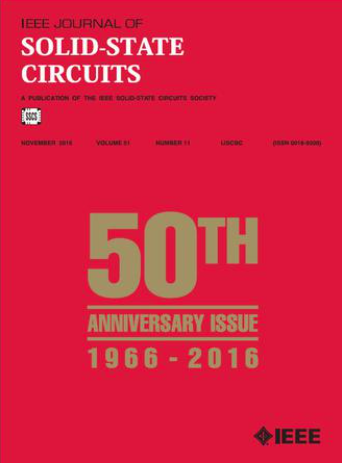A 32 Gb/s 0.36 pJ/bit 3 nm Chiplet IO Using 2.5-D CoWoS Package With Real-Time and Per-Lane CDR and Bathtub Monitoring
IF 4.6
1区 工程技术
Q1 ENGINEERING, ELECTRICAL & ELECTRONIC
引用次数: 0
Abstract
This article presents a high-density, single-ended non return to zero (NRZ) chiplet I/O implemented with 3 nm CMOS technology on a 2.5-D chip-on-wafer-on-substrate (CoWoS) interposer, accommodating trace lengths up to 2 mm. The design features 216 data lanes, each operating at 32 Gb/s. For the tested 2-mm trace, the channel insertion loss and crosstalk at the Nyquist frequency are −2.4 and −18.1 dB, respectively. The receiver (RX) includes real-time clock data recovery (CDR) and a bathtub monitor for each lane, optimizing sampling point adjustments and tracking phase drift across voltage and temperature variations. With all lanes active, the physical layer (PHY) achieves a density of 3.84 Tb/s/mm and operates with a power consumption of 0.36 pJ/bit. The worst-performing lane shows a 0.342 UI opening at a bit error rate (BER) of 1e−12, and an interpolated 0.331 UI opening at a BER of 1e−15 when running at 32 Gb/s. Additionally, results for 25 Gb/s operation are included as a lower power alternative. This article will discuss the design details and trade-offs of the transceiver.基于2.5 d coos封装的32gb /s 0.36 pJ/bit 3nm芯片IO,具有实时单通道话单和浴缸监控
本文介绍了一种高密度、单端不归零(NRZ)芯片I/O,采用3nm CMOS技术在2.5 d片上片上衬底(coos)中间层上实现,可容纳最长2 mm的走线长度。该设计具有216个数据通道,每个通道的运行速度为32gb /s。对于测试的2mm走线,奈奎斯特频率下的通道插入损耗和串扰分别为- 2.4和- 18.1 dB。接收器(RX)包括实时时钟数据恢复(CDR)和每个通道的浴缸监视器,优化采样点调整并跟踪电压和温度变化的相位漂移。在所有通道激活的情况下,物理层(PHY)的密度达到3.84 Tb/s/mm,功耗为0.36 pJ/bit。表现最差的通道在误码率(BER)为1e−12时的UI开度为0.342,而在32gb /s运行时,UI开度为0.331,误码率为1e−15。此外,25 Gb/s操作的结果也包含在更低功耗的替代方案中。本文将讨论收发器的设计细节和权衡。
本文章由计算机程序翻译,如有差异,请以英文原文为准。
求助全文
约1分钟内获得全文
求助全文
来源期刊

IEEE Journal of Solid-state Circuits
工程技术-工程:电子与电气
CiteScore
11.00
自引率
20.40%
发文量
351
审稿时长
3-6 weeks
期刊介绍:
The IEEE Journal of Solid-State Circuits publishes papers each month in the broad area of solid-state circuits with particular emphasis on transistor-level design of integrated circuits. It also provides coverage of topics such as circuits modeling, technology, systems design, layout, and testing that relate directly to IC design. Integrated circuits and VLSI are of principal interest; material related to discrete circuit design is seldom published. Experimental verification is strongly encouraged.
 求助内容:
求助内容: 应助结果提醒方式:
应助结果提醒方式:


